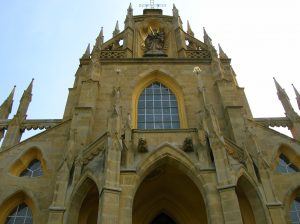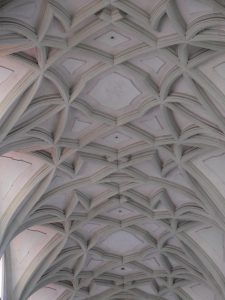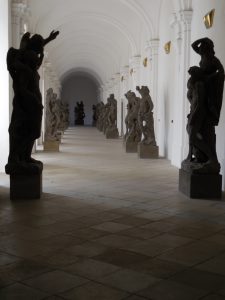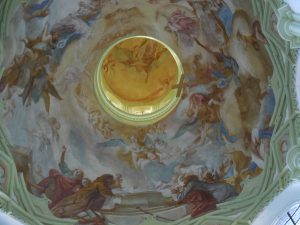Kladruby Monastery: A jewel of west Bohemia
By Tracy A. Burns
 There are many reasons why tourists should visit Kladruby Monastery in west Bohemia. Visitors will become familiar with the unique “Baroque-Gothic” style of architecture, will see stunning Late Baroque statuary, will be amazed by the 16th-century woodcuts, and will be enthralled by an exposition about the Czech patron saint of Bohemia, John of Nepomuk. And those are just the highlights.
There are many reasons why tourists should visit Kladruby Monastery in west Bohemia. Visitors will become familiar with the unique “Baroque-Gothic” style of architecture, will see stunning Late Baroque statuary, will be amazed by the 16th-century woodcuts, and will be enthralled by an exposition about the Czech patron saint of Bohemia, John of Nepomuk. And those are just the highlights.
History of Kladruby Monastery up to the 16th century
Kladruby Monastery dates back to 1115 when it was founded by Prince Vladislav I. The monastery was built along the Prague – Nuremberg trade route that led to the Baltic Sea. It enjoyed prosperity from the end of the 12th century to the mid-1300s. Bohemian King Přemysl Otakar I held an important meeting with members of the Prague bishopric here during the 13th century. One of the most accomplished kings of Bohemia, Wenceslas I, attended the ceremony consecrating the monastic Church of the Assumption of the Virgin Mary, Saint Wolfgang, and Saint Benedict in 1233. During the Hussite Wars of the 15th century, both the Hussites and then the army of Emperor Sigismund conquered the monastery, causing much destruction. Kladruby monastery was in shambles for 70 years.
The Thirty Years’ War and its aftermath
The early 16th century brought prosperity to the monastery Yet the good times came to an abrupt halt when the Thirty Years’ War began, bringing havoc to the Czech lands as the Catholics fought against the Protestants. Then the Catholic victory gave the monastery a new lease on life.
How Santini comes into the picture
The early 18th century was a fruitful time of expansion and reconstruction. That’s when Jan Blažej-Santini Aichel, a Czech architect of Italian origin, was hired to rebuild the church. From 1711 to 1726, the church was molded into his unique Baroque Gothic style, which integrated Gothic elements in a Baroque fashion, harmonizing the two styles.
Depressing times until the 1960s
Emperor Joseph II dissolved the monastery in 1785, and then the property fell into the hands of the Windisch-Graetz family, who turned one building into a brewery and made other spaces into apartments. However, the clan’s tenure did have a positive effect as an impressive library was created. In 1945 the state took control of the monastery. Under Communism, part of the complex was occupied by sick cattle while other sections were turned into offices. Reconstruction began in the mid-1960s and continued through the 1990s.
Santini’s Baroque Gothic style
 Santini preserved some of the Romanesque features of the church and used many Gothic elements in his style. The new western façade has a distinctly Gothic appearance while the dome is pure Late Baroque. Brilliant frescoes decorate the interior as do eight-pointed stars, a symbol of the Virgin Mary. Santini also designed the high altar that features scenes from the life of Jesus Christ and also offers a history lesson of the Benedictine Order, among other portrayals. Master Late Baroque sculptor Matthias Bernard Braun created this dazzling work of art punctuated by both Baroque and Gothic elements. (Braun’s statuary can also be seen on Prague’s Charles Bridge and at Kuks Hospital in east Bohemia, for example.) Santini was responsible for the pulpit, shaped as a ship on a stormy sea, the choir pews and the case of the still functional Baroque organ, too.
Santini preserved some of the Romanesque features of the church and used many Gothic elements in his style. The new western façade has a distinctly Gothic appearance while the dome is pure Late Baroque. Brilliant frescoes decorate the interior as do eight-pointed stars, a symbol of the Virgin Mary. Santini also designed the high altar that features scenes from the life of Jesus Christ and also offers a history lesson of the Benedictine Order, among other portrayals. Master Late Baroque sculptor Matthias Bernard Braun created this dazzling work of art punctuated by both Baroque and Gothic elements. (Braun’s statuary can also be seen on Prague’s Charles Bridge and at Kuks Hospital in east Bohemia, for example.) Santini was responsible for the pulpit, shaped as a ship on a stormy sea, the choir pews and the case of the still functional Baroque organ, too.
Matthias Bernard Braun and Saint John of Nepomuk
 In the ambulatory visitors can gaze at Braun’s sandstone Late Baroque statues, some inspired by Roman and Greek history, others depicting allegories of human characteristics. All but one are original. Another exposition features about 500 sculptures, paintings, and portraits of the Czech patron saint of Bohemia, John of Nepomuk, whose fate is closely tied to the monastery. During the late 14th century, he confirmed the archbishop’s choice for the abbot, angering King Wenceslas IV of Bohemia, who did not support the Pope in Rome. On the king’s orders, John of Nepomuk was tortured and drowned in the Vltava River. He was canonized in 1729.
In the ambulatory visitors can gaze at Braun’s sandstone Late Baroque statues, some inspired by Roman and Greek history, others depicting allegories of human characteristics. All but one are original. Another exposition features about 500 sculptures, paintings, and portraits of the Czech patron saint of Bohemia, John of Nepomuk, whose fate is closely tied to the monastery. During the late 14th century, he confirmed the archbishop’s choice for the abbot, angering King Wenceslas IV of Bohemia, who did not support the Pope in Rome. On the king’s orders, John of Nepomuk was tortured and drowned in the Vltava River. He was canonized in 1729.
Other features of the monastery
In the Dining Room, take a good look at the portrait of Cardinal Schwarzenberg. His eyes are always looking at you, no matter where you are standing. Twelve woodcuts depicting scenes from Christ’s childhood hail from the 16th century. The Windisch-Graetz Library includes 33,000 volumes and displays of weaponry and travel souvenirs. Kladruby’s claim to fame is not only the monastery but also the renowned stud farm where Kladruber horses are bred.
One of the most beautiful places in Bohemia
 Kladruby Monastery ranks among the most beautiful and most intriguing places in Bohemia. The third biggest church in the Czech lands is an architectural wonder. Both Santini and Braun were masters at their trades as is evident in their work at the monastery. John of Nepomuk played a prominent role in Czech history. Kladruby is an awe-inspiring stop for sightseers, offering intriguing lessons in Czech history.
Kladruby Monastery ranks among the most beautiful and most intriguing places in Bohemia. The third biggest church in the Czech lands is an architectural wonder. Both Santini and Braun were masters at their trades as is evident in their work at the monastery. John of Nepomuk played a prominent role in Czech history. Kladruby is an awe-inspiring stop for sightseers, offering intriguing lessons in Czech history.




